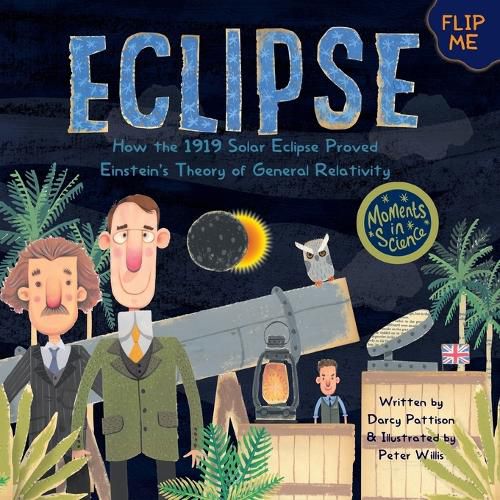Readings Newsletter
Become a Readings Member to make your shopping experience even easier.
Sign in or sign up for free!
You’re not far away from qualifying for FREE standard shipping within Australia
You’ve qualified for FREE standard shipping within Australia
The cart is loading…






This title is printed to order. This book may have been self-published. If so, we cannot guarantee the quality of the content. In the main most books will have gone through the editing process however some may not. We therefore suggest that you be aware of this before ordering this book. If in doubt check either the author or publisher’s details as we are unable to accept any returns unless they are faulty. Please contact us if you have any questions.
In 1915, British astronomer Arthur Stanley Eddington was fascinated with Einstein’s new theory of general relativity. The theory talks about how forces push and pull objects in space. Einstein said that the sun’s gravity could pull and bend light.
To test this, astronomers decided to photograph the 1919 solar eclipse. The eclipse would allow them to photograph the stars before and during the solar eclipse. If the star’s position moved, then it was evidence that that light had bent. Eddington and his team traveled from England to the island of Principe, just off the African coast, to photograph the eclipse.
In simple language, this nonfiction illustrated picture book explains how the push (acceleration) and pull (gravity) of space affects light.
Back matter includes information on Einstein, Eddington, and the original photograph of the 1919 solar eclipse.
The text of the book is wonderfully clear and easy to follow, and the illustrations are great, both lively and informative. The story of the eclipse unfolds dramatically, and the science is explained vividly and correctly. Daniel John Kennefick, Astrophysicist and Science Historian
MOMENTS IN SCIENCE COLLECTION
This exciting series focuses on small moments in science that made a difference.
BURN: Michael Faraday’s Candle CLANG! Ernst Chladni’s Sound Experiments (2019 NSTA Outstanding Science Trade Book) POLLEN: Darwin’s 130 Year Prediction (Junior Library Guild selection, starred Kirkus review) ECLIPSE: How the 1919 Eclipse Proved Einstein’s Theory of General Relativity (Fall, 2019)
$9.00 standard shipping within Australia
FREE standard shipping within Australia for orders over $100.00
Express & International shipping calculated at checkout
This title is printed to order. This book may have been self-published. If so, we cannot guarantee the quality of the content. In the main most books will have gone through the editing process however some may not. We therefore suggest that you be aware of this before ordering this book. If in doubt check either the author or publisher’s details as we are unable to accept any returns unless they are faulty. Please contact us if you have any questions.
In 1915, British astronomer Arthur Stanley Eddington was fascinated with Einstein’s new theory of general relativity. The theory talks about how forces push and pull objects in space. Einstein said that the sun’s gravity could pull and bend light.
To test this, astronomers decided to photograph the 1919 solar eclipse. The eclipse would allow them to photograph the stars before and during the solar eclipse. If the star’s position moved, then it was evidence that that light had bent. Eddington and his team traveled from England to the island of Principe, just off the African coast, to photograph the eclipse.
In simple language, this nonfiction illustrated picture book explains how the push (acceleration) and pull (gravity) of space affects light.
Back matter includes information on Einstein, Eddington, and the original photograph of the 1919 solar eclipse.
The text of the book is wonderfully clear and easy to follow, and the illustrations are great, both lively and informative. The story of the eclipse unfolds dramatically, and the science is explained vividly and correctly. Daniel John Kennefick, Astrophysicist and Science Historian
MOMENTS IN SCIENCE COLLECTION
This exciting series focuses on small moments in science that made a difference.
BURN: Michael Faraday’s Candle CLANG! Ernst Chladni’s Sound Experiments (2019 NSTA Outstanding Science Trade Book) POLLEN: Darwin’s 130 Year Prediction (Junior Library Guild selection, starred Kirkus review) ECLIPSE: How the 1919 Eclipse Proved Einstein’s Theory of General Relativity (Fall, 2019)